After completing an adventure with the historical Spanish side, RC Deportivo de La Coruña, the 38-year-old Borja Jiménez signed on for a new challenge in charge of the prestigious CD Leganés. Following an unsuccessful project last season, this Spanish side is leading the Segunda Division with 35 points (11 wins, two draws and three defeats).
Overall, they profile as a quite balanced team during the different stages of the game, yet it must be said that they clearly stand out due to their impressive defensive record: only seven goals conceded in 16 games.
Furthermore, they also boast the second-best attack in their division, with 26 goals to their name for the current campaign at the time of writing. Such offensive success is mainly attributed to Miguel de la Fuente and Dani Raba, who have tallied up eight and ten direct goal contributions this season, respectively.
Leganés are looking forward to returning to the biggest stage in Spanish football and are currently on course to do so, where they could face teams like Real Madrid, Barcelona, Atlético de Madrid, among many more.
This tactical analysis will outline Jiménez’s philosophy, which relies on consistent defence and an opportunistic offensive approach.
Defensive
Depending on which team they face, they feel comfortable defending in a low-medium block. The defensive line comprises five elements: three centre-backs and two full-backs. The wingers join the two midfielders, leaving the striker (normally De la Fuente) as a solitary pressing element.
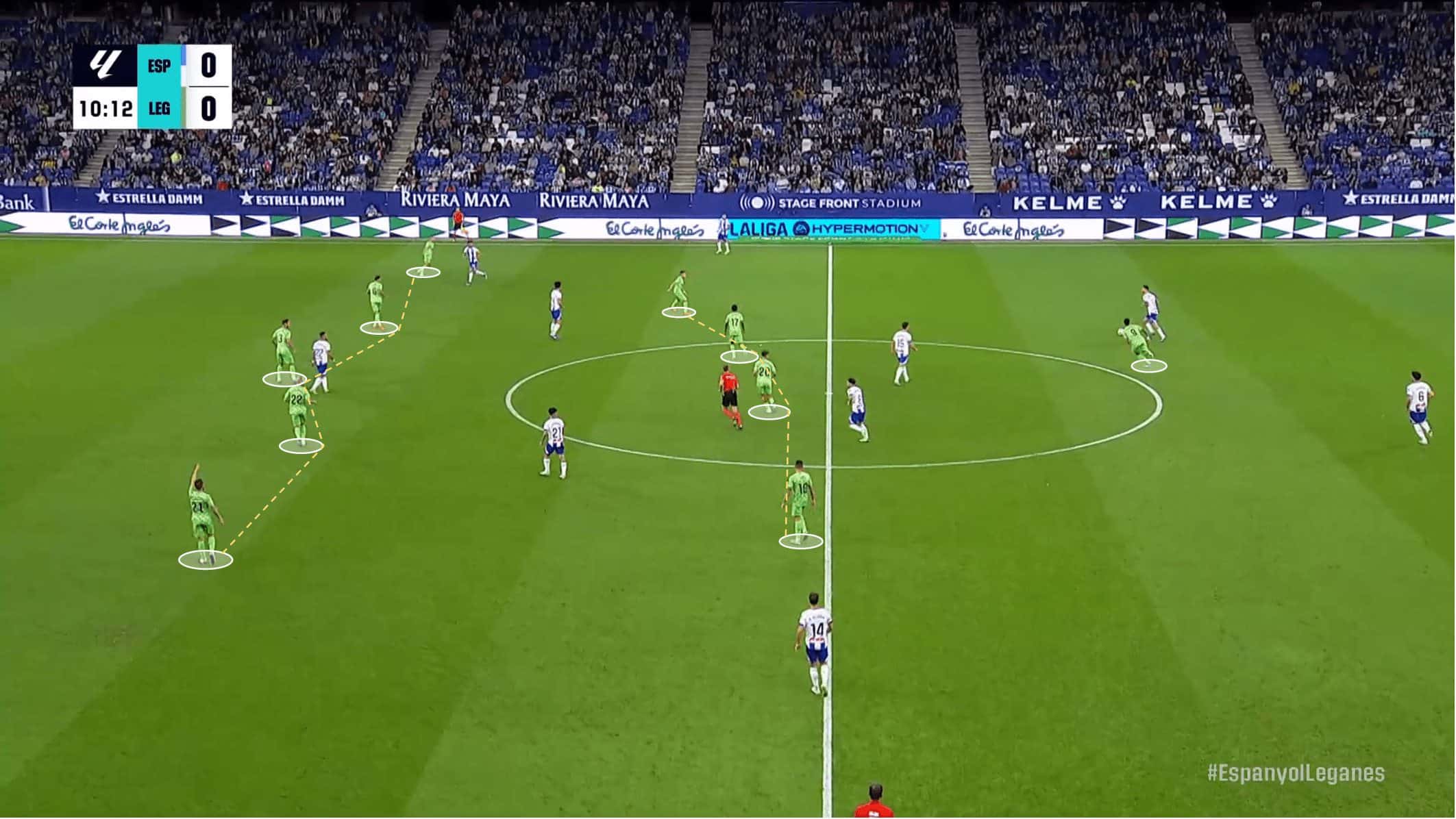
The other team’s formation could also result in Leganés employing different pressing tactics, where one of the wingers would join the De la Fuente, for example, in a three-man build-up.
Generally speaking, Leganés are a very organised team, especially when discussing the most backtracked elements. As we mentioned, they are not typically a high-pressing team; instead, they wait with expectancy for the other team’s error.
They have the covered and uncovered ball situations quite inherent, supporting their defensive tasks. Having that said, the team understands the right moment to increase or decrease their lines. The defensive line dictates such movement, yet, as we see above, the team functions as a whole and follows their momentum.
We’re going to detail further, but one of Leganés’ biggest offensive strengths is related to their transitions. We find referring to this on the defensive moment relevant due to its intrinsic relation. Indeed, we can’t speak of a counterattack without mentioning the previous off-possession situation.
The “Pepineros” backline privileges their original structure rather than marking the ball carrier, a strategy that aims for defensive cohesion. For example, when the winger is playing inside, the full-back prefers to maintain his positioning than try to steal the ball.
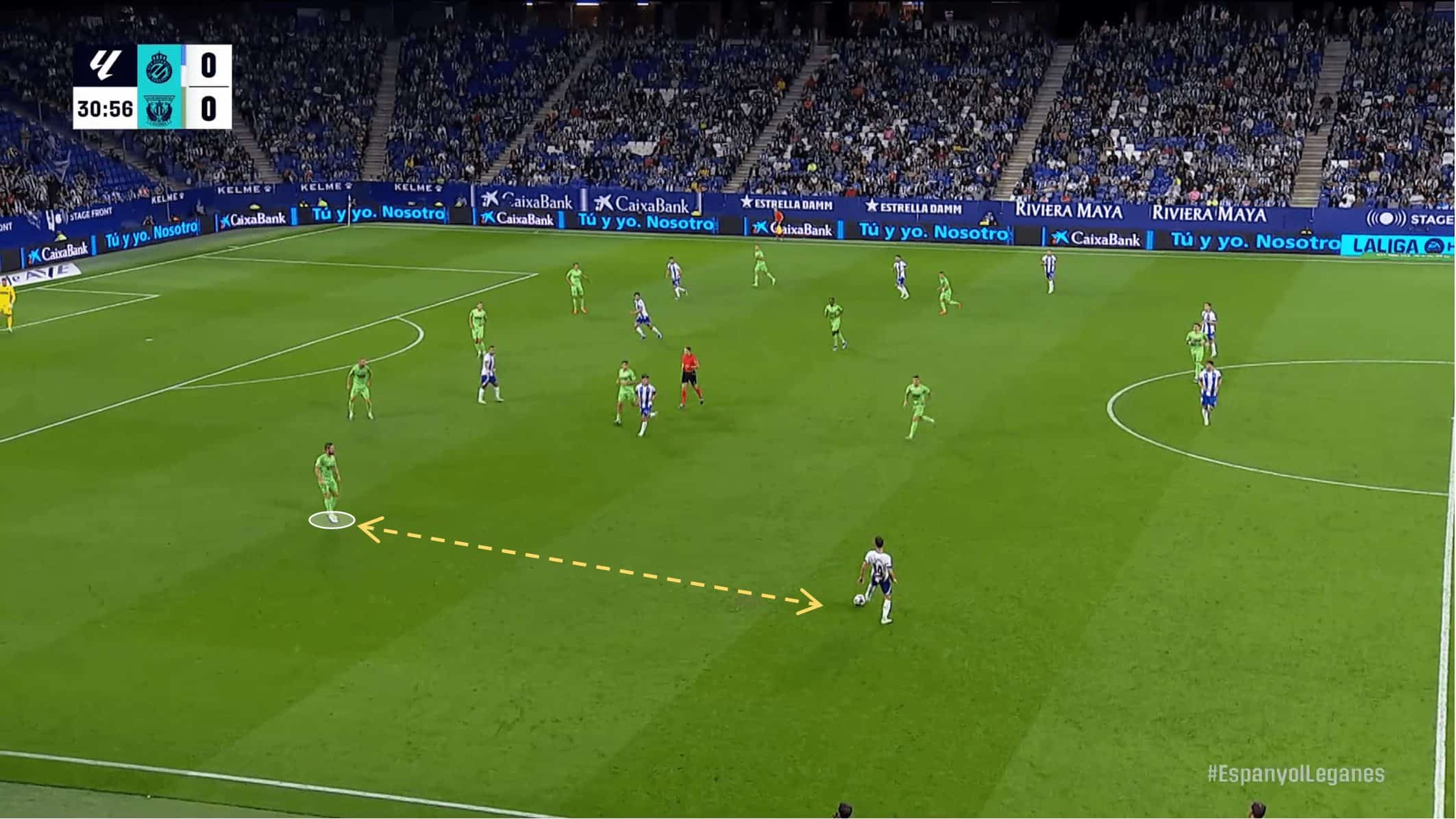
Because the movement is inevitable while attacking, we found that some gaps are created inside Lega’s defensive lines. For example, a void is established if one of the centre-backs follows an attacker’s inside-outside movement. This is due to the other defender’s fixed positioning.
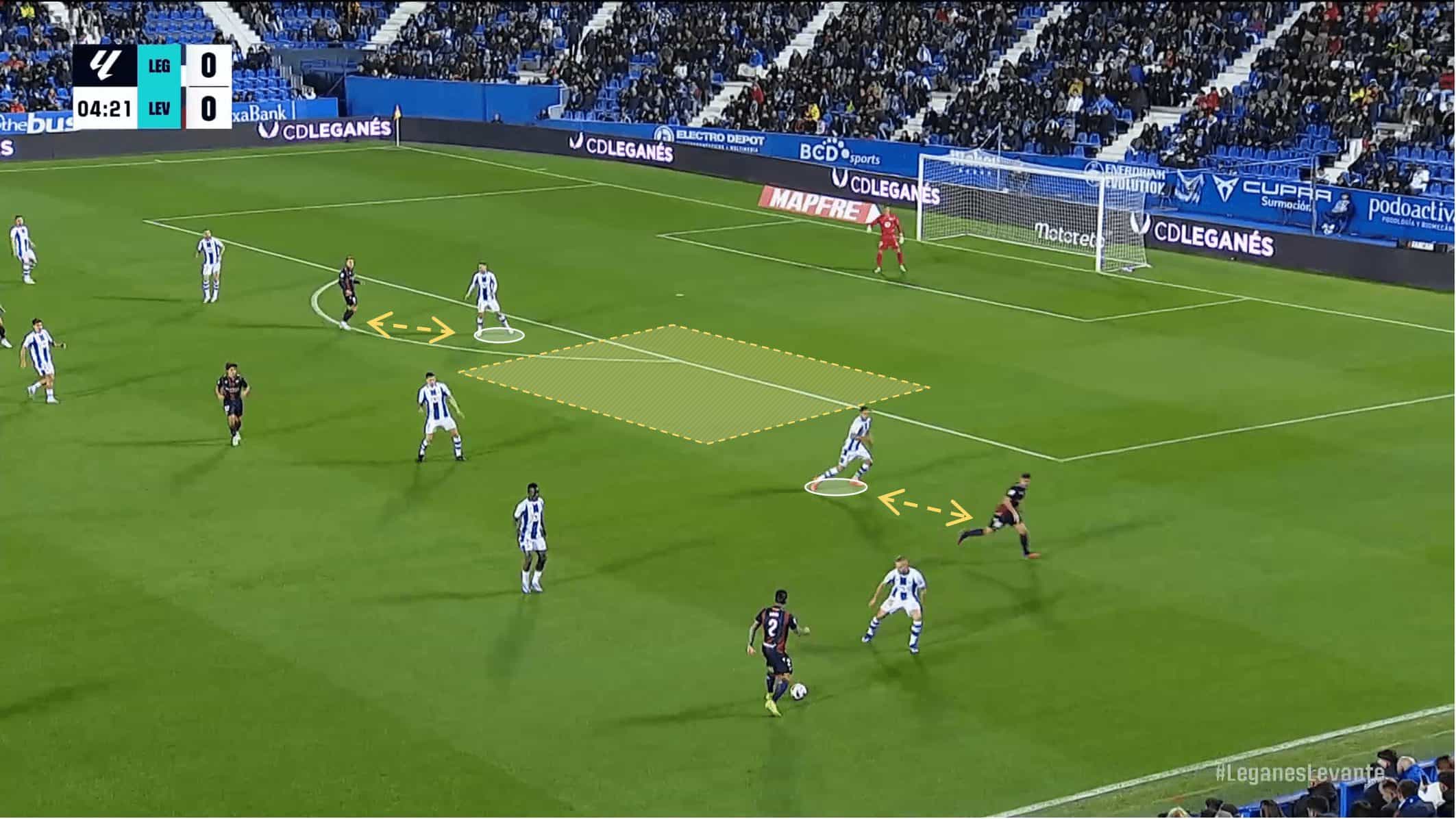
In our view, one element of Jiménez’s defensive brand is related to the centre-back’s behaviour. One of their most important tasks is to close the gap between themselves and the midfield line. This is possible due to their constant surveillance of the attackers’ movements.
Some teams feel more comfortable threatening via the wings; in this case, the centre-backs have a simpler task. The example below reveals a game situation against Espanyol. Their interior game is a constant, and as it is displayed in the following image, the centre-backs follow the attackers’s movement.
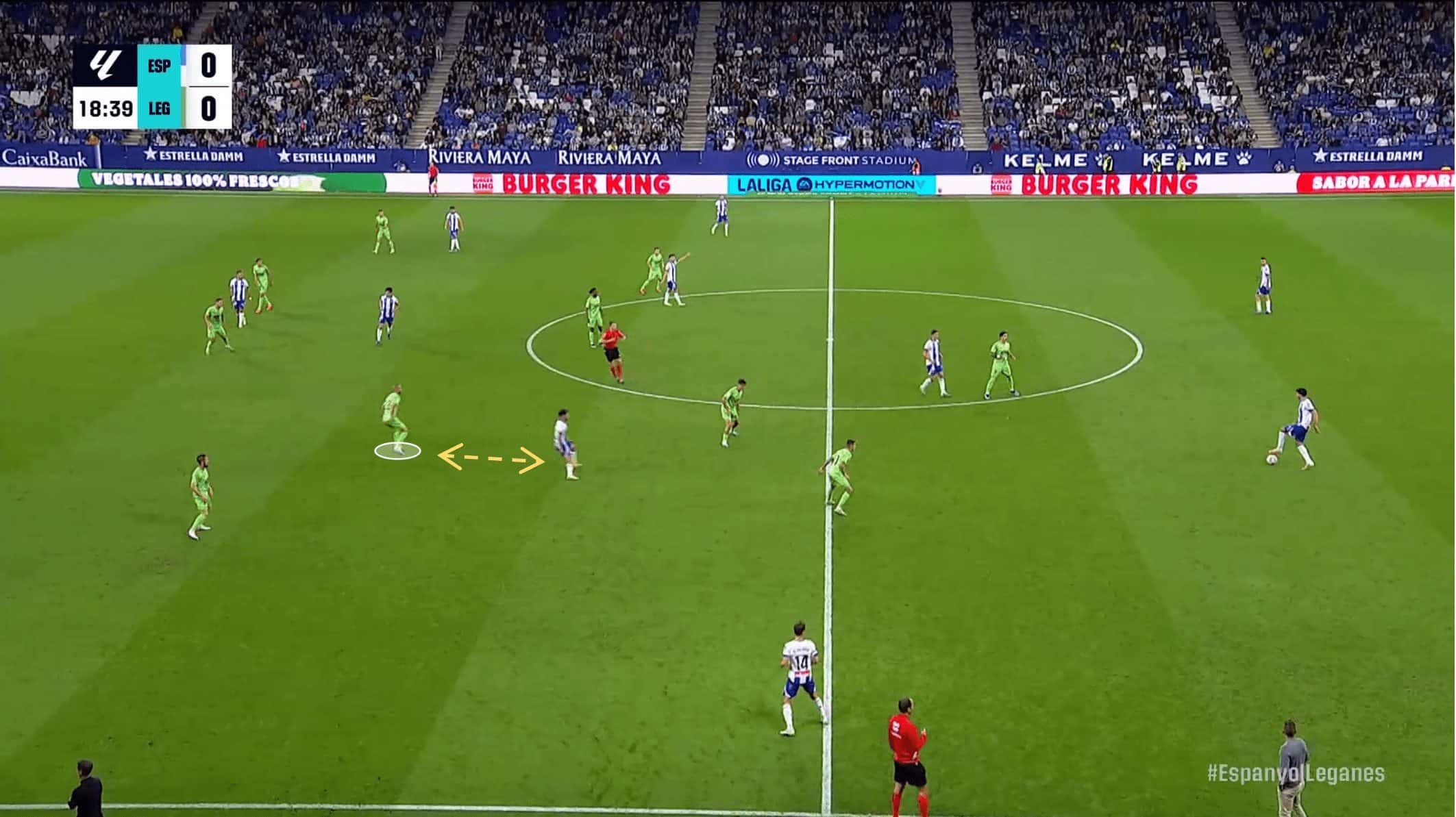
As we referred to, man-marking has advantages, like obstructing the opposition’s interior game intentions and disadvantages, such as creating significant defensive gaps. For example, the opponent can contour this strategy by having a player descend, and the other make a diagonal into the depth.
Apart from the tactical strategy, we also would like to address the mental aspect as vital for the success of Leganés while defending. In contrast to what we see in other teams, in Lega, all the players have an identical work rate, where, for instance, the top goal scorer’s intensity is similar to that of a less prominent player.
That said, the Pepineros are known as a mature and close-knit squad while defending. Their defensive transition is evidence of such commitment and engagement where their reaction is one of the best in the league.
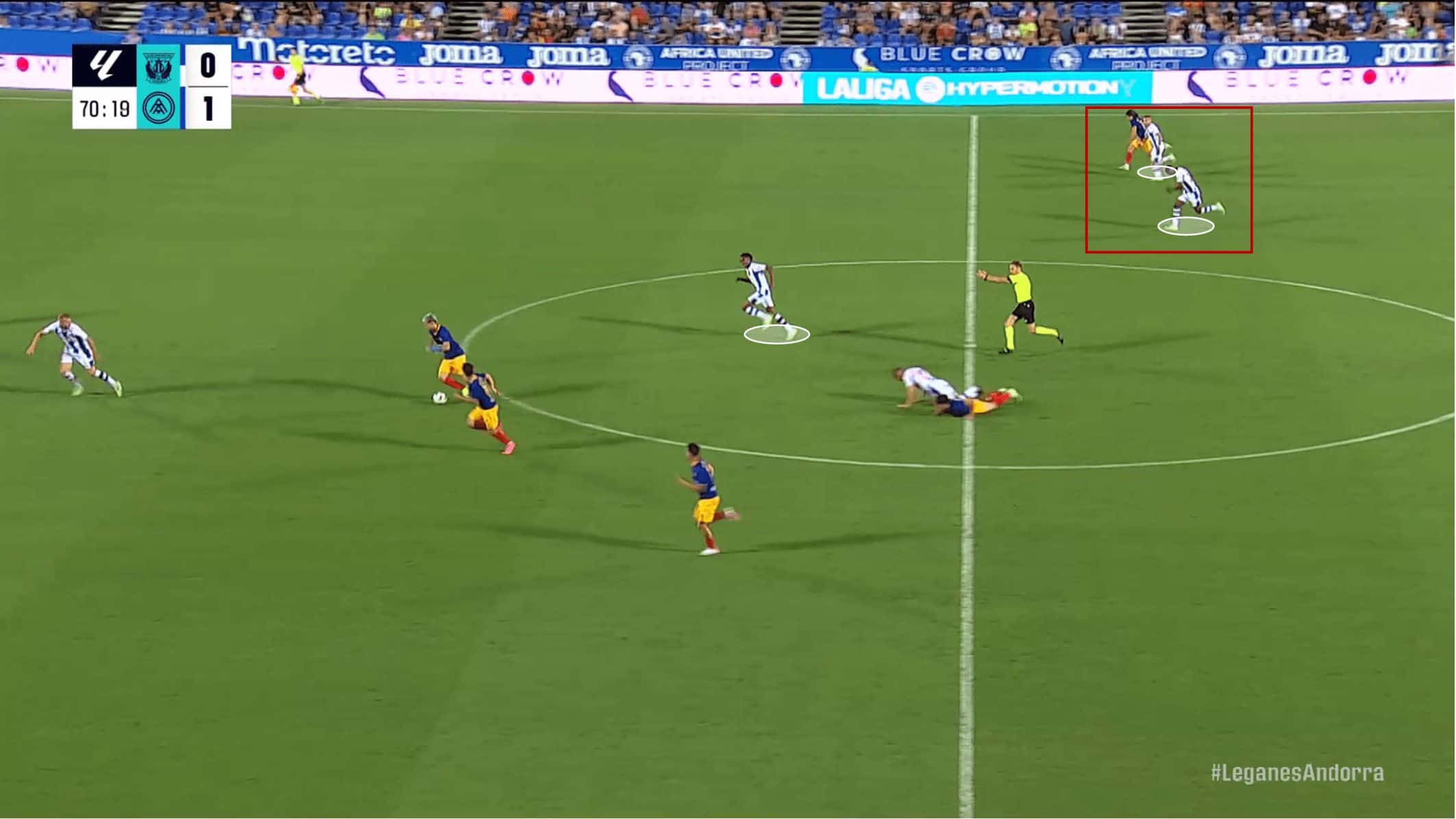
As it’s visible above, the element who lost or the player who is nearer the ball carrier is the first to react, and the whole team adjusts in function of him.
Playing with three centre-backs can have several advantages, such as a less-risky approach while building up or even the possibility of projecting the full-backs. Yet, as we see it, one of the strongest reasons which led Jiménez to choose this system could be related to their defensive strategy, especially in the prevention of counterattacks.
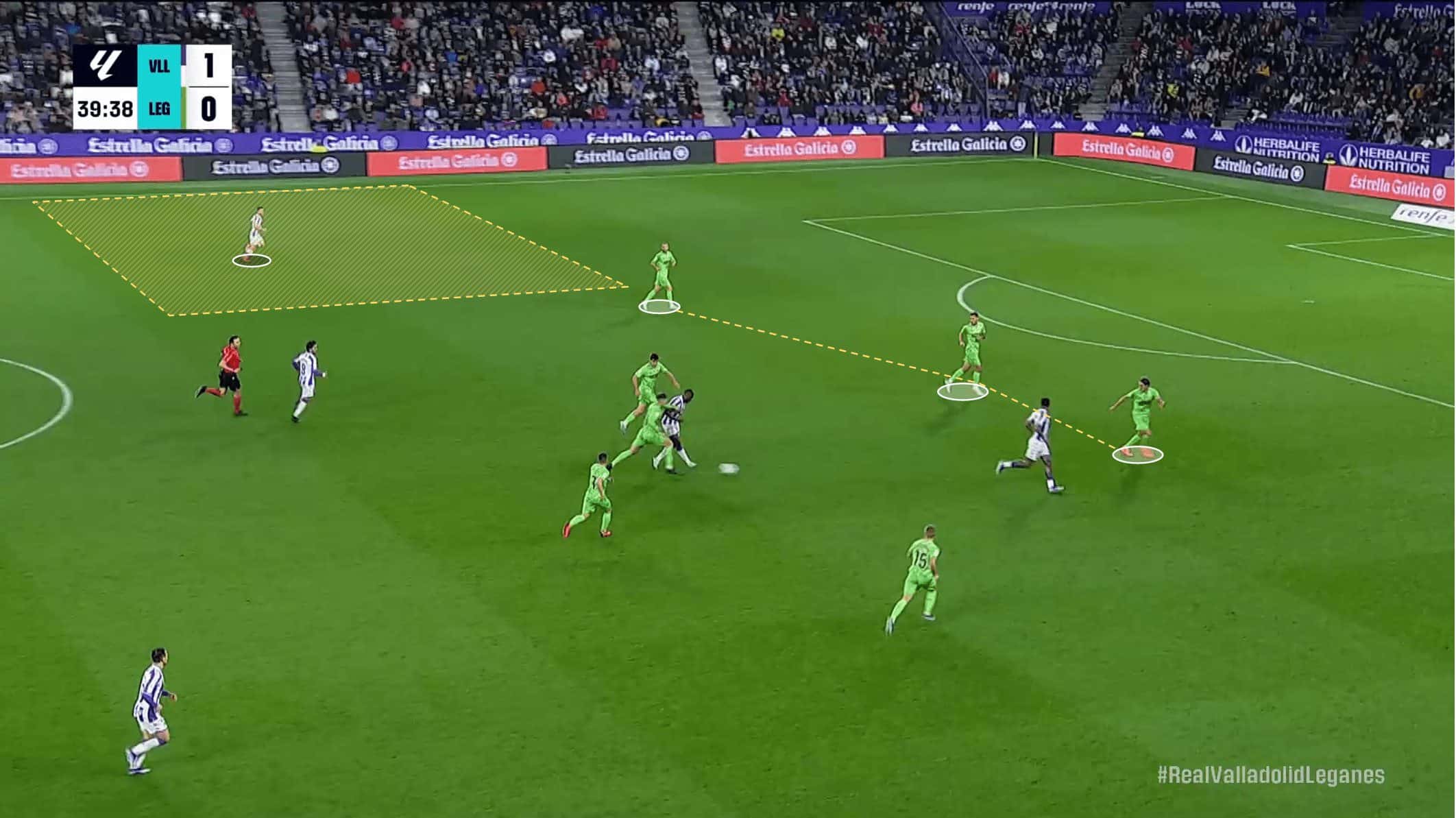
The fact that both full-backs, in some offensive organisation situations, play deep decreases their odds of intercepting the ball carrier during a defensive transition. However, playing with three centre-backs mitigates the problem, and the grand responsibility goes to the midfielders, who must maintain their opponents’ pace.
Offensive
Apart from their outstanding defensive record, Leganés’ attack is a process that deserves our full consideration. They are a team that endorses a short pass build-up with a low-risk approach. They’re not a team characterised by their outstanding technique or capacity to play out; on the contrary, we felt some difficulties in the building process when confronted with a high pressing level.
Leganés maintain their three centre-backs while starting their play with the full-backs in an intermediate position. These two players give width to their team’s offensive strategy. However, their positional depth depends on the opposition’s pressing plan. For instance, if they are pressed heavily, the full-backs are deeper and vice versa.
The two central midfielders play right in front of the defensive line and function as linking elements for the more advanced elements. Moreover, the Spanish head coach instructs his two wingers to position in more central zones, functioning as offensive midfielders and as supporters for the solo striker.
That said, we concluded that Leganés preferentially attack in a 3-2-4-1 or 3-4-2-1 if the full-backs are dropped down on the pitch.
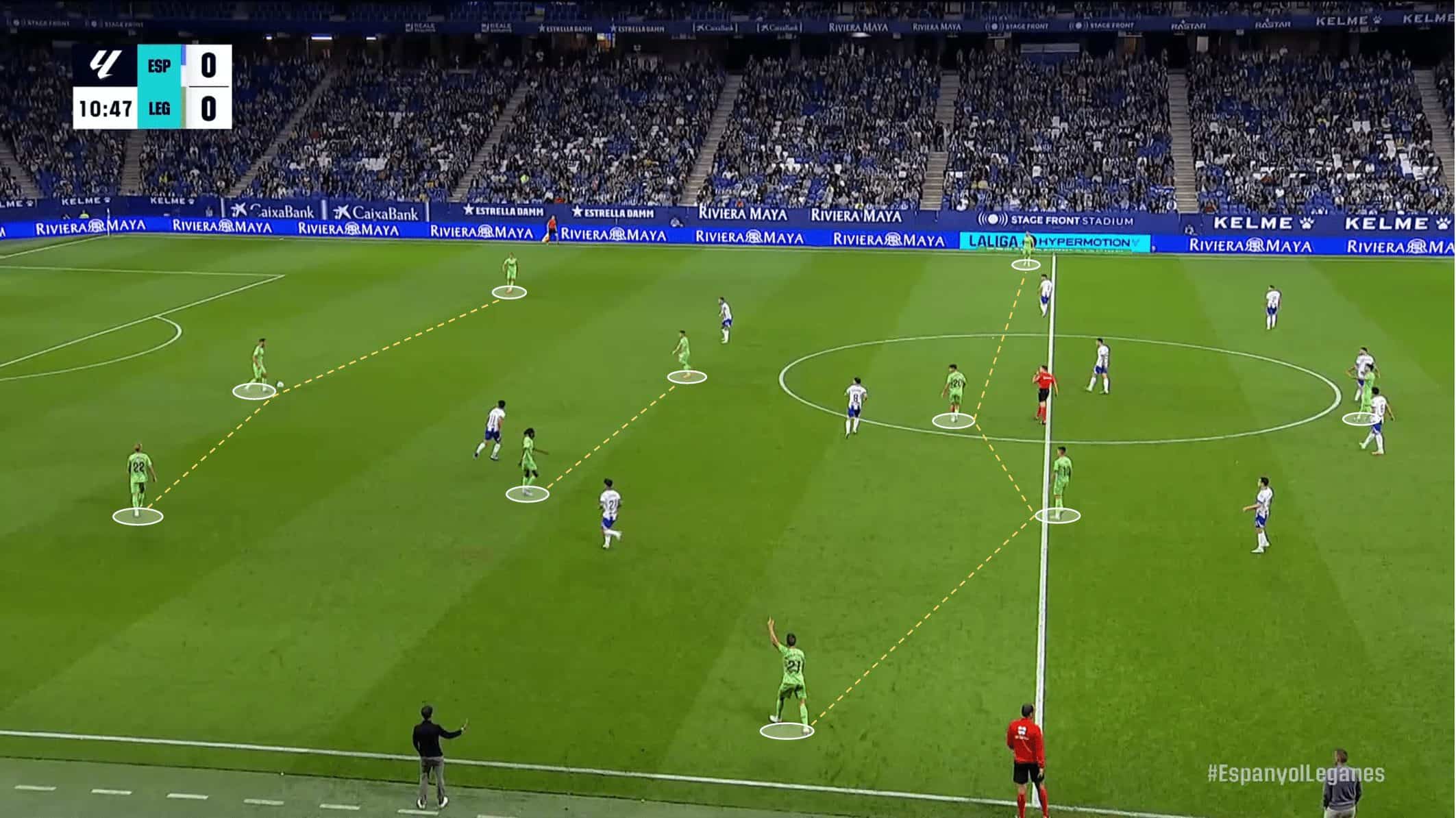
We also want to give continuity to the winger’s interesting positioning while in possession. This is a commonly used strategy by teams with full-backs capable of threat by the wing, like Portugal, with João Cancelo and Diogo Dalot. For this offensive nuance to work out, there must be a high coordination level between these elements (winger and full-back). Using the example above, we see Bernardo Silva adapting his positioning to Cancelo’s and vice-versa.
Although in a different perspective at Leganés, these two positions are well coordinated regarding depth. As a matter of fact, it’s improbable to see the full-backs exploring more interior zones, leaving this task to the winger.
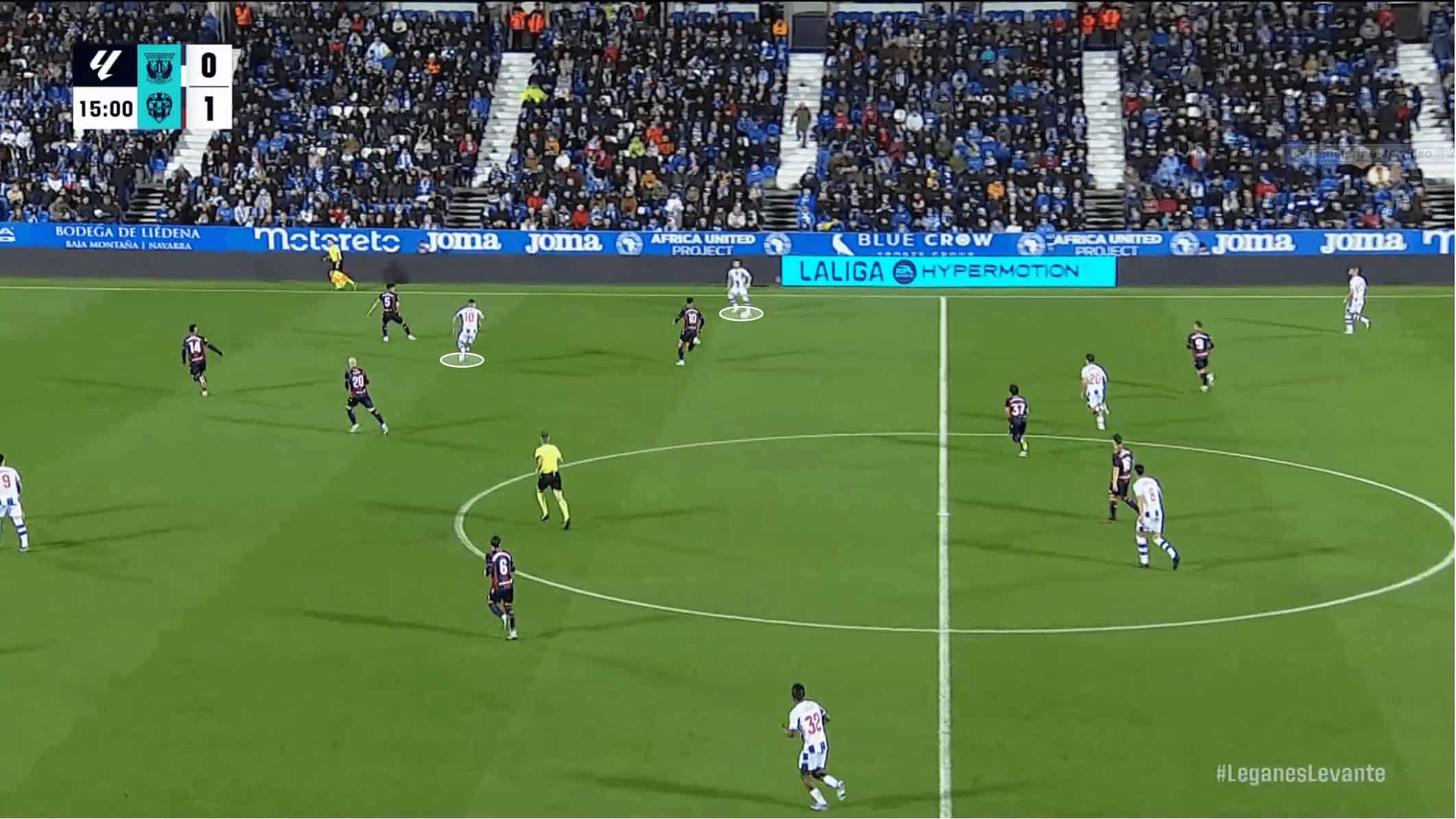
This behaviour is essential because it prevents imbalances while attacking. For instance, having two deep players by the wing could foster an ineffective defensive transition. Again, as we saw previously, the different moments of the game are all connected, and we should integrate them.
If Lega plays with three centre-backs, the ball-side full-back is the one who normally descends to form the three-man build-up line, yet as we’re going to see, these players can be simultaneously high on the pitch.
They aren’t highly rushed near the opposition’s box; instead, they privilege the ball circulation, especially through the flanks. This is their primary entry for a dangerous play, where the ball is most likely to be crossed.

The affluence and the number of players available in finishing zones depend on the type of play they are into. If they are organised, and the block goes up progressively, then the number of elements inside the box is elevated, as it’s visible above.
In this strategy, both full-backs are positioned deep, allowing one to cross while the other attacks the far post inside the box. It’s interesting because we rank Leganés as a low-risky team while attacking, yet they have this strategy which could jeopardise their defensive cohesion.
Apart from the flanks, the “Pepineros” also feel comfortable trying to rupture the opposition’s backline through interior passes. The wingers are normally the players entrusted to do depth attacks while the midfielders or centre-backs pass.

Moreover, in a box entrance zone, a shot can also be a viable option, especially when the ball carrier is Lega’s technician, Raba.
Let’s now focus on what, in our opinion, is Leganes’ biggest offensive weapon. We’re talking about their offensive transition. According to Wyscout, they make around two counterattacks per game, a relatively high number. Furthermore, they are also an effective team while conducting such transitions, where approximately 55% of their counterattacks ended up with a shot.
A strong and offensive stimulus is necessary to execute a fast counterattack, especially when the possession is restored.
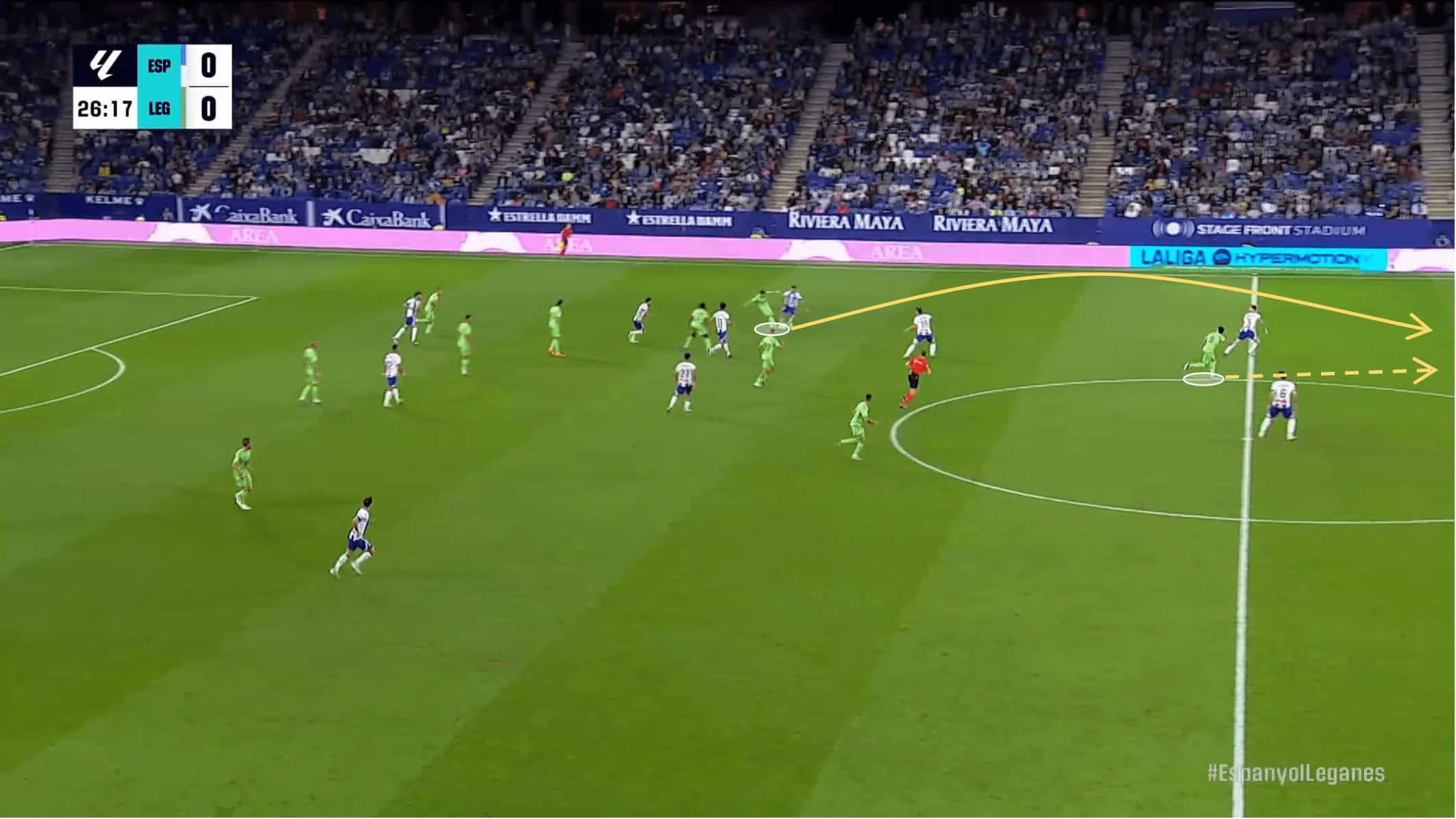
Above, we see what we just discussed: De la Fuente quickly seeks the back of the defenders and the ball carrier with his head up to seek him.
De la Fuente’s recent offence had, in great part, to do with his and his team’s pragmatism while attacking. For every shot this season, 43% were in the goal’s direction, while the opposition had a 28% accuracy rate.
Besides his effectiveness, which makes him the second-best goalscorer in the league, is his unpredictability — another decisive factor in his game. This is visible, for example, in his positioning, where, for example, he’s seen by the corridor, possibly to misguide his defenders and create space to play.
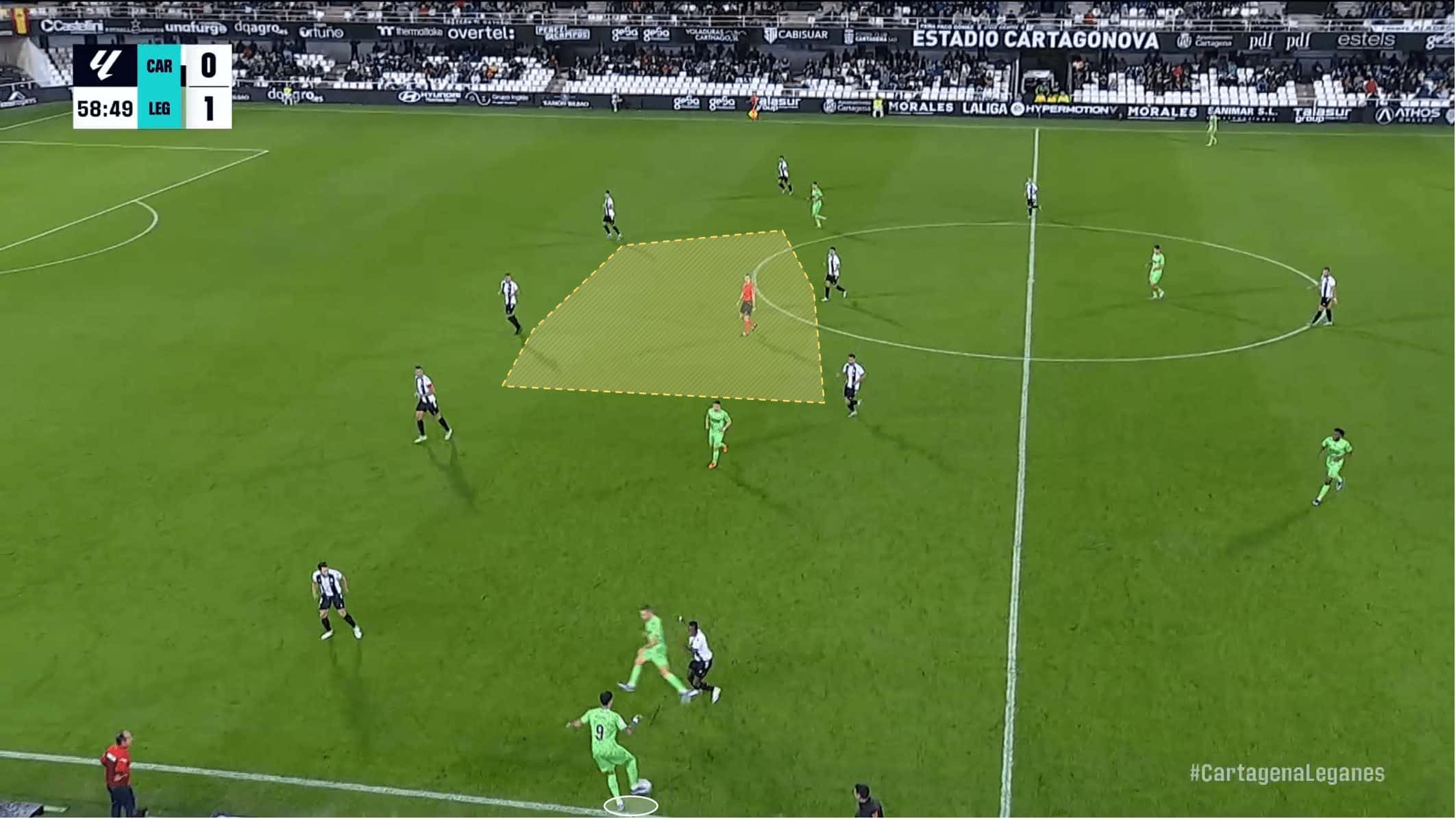
In our opinion, this also has to do with a method to gain confidence, especially in games where he struggles to touch the ball and diversifies his positioning so that he increases the odds of being a most likely pass-target.
Besides transitions, Leganés can also threaten via set pieces, especially corners.
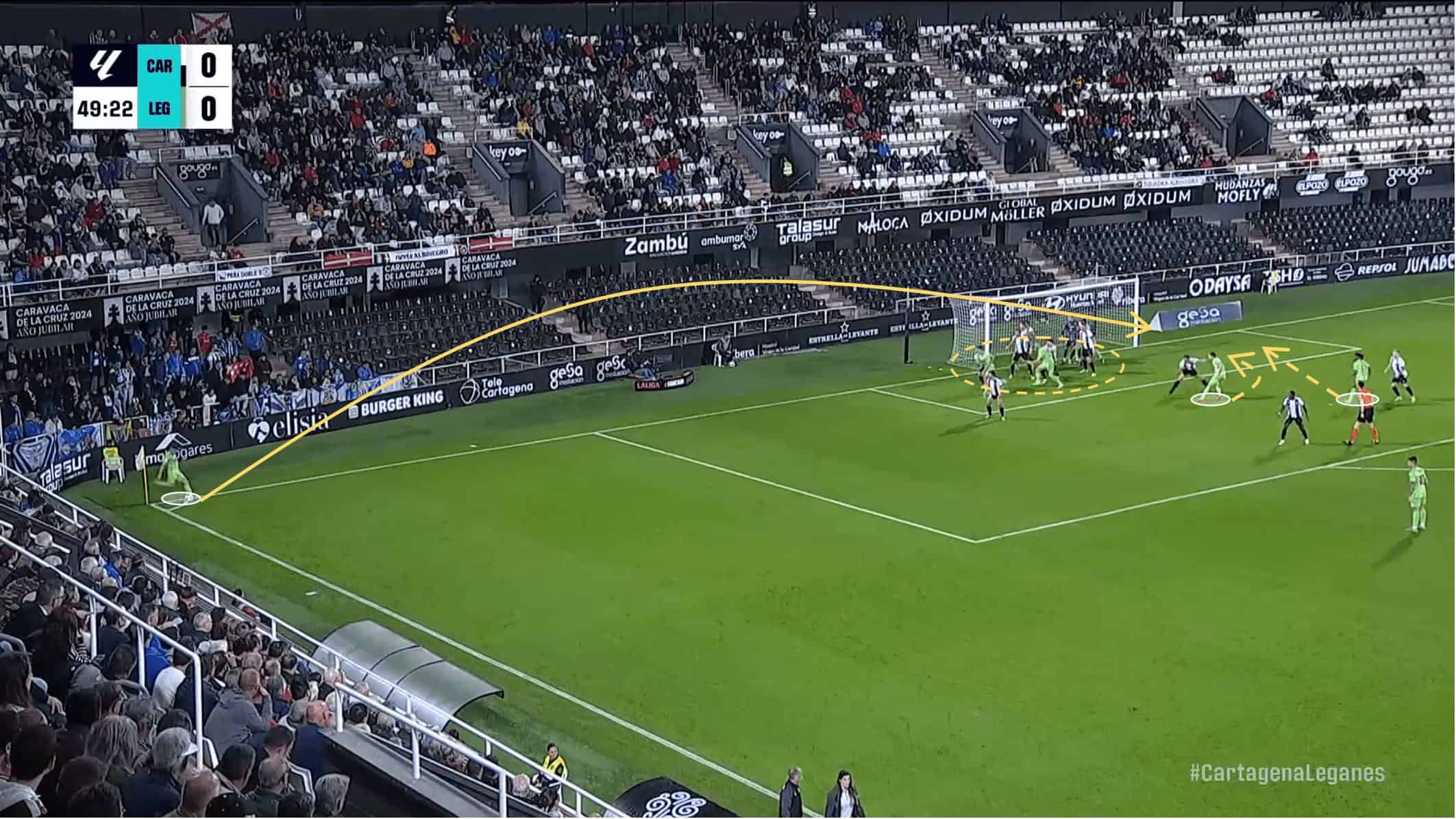
Jiménez designed a strategy where he overloaded the near post and the goal area to disturb the goalkeepers’ performance and create space in the far post to attack. In our view, it’s a smart strategy because of its unpredictability; on the one hand, the player on the near post can deviate and hit the target. However, they can also deviate to the second post, where the number of defenders is considerably lower.
For this strategy to work, it’s mandatory to possess a good corner taker like Raba, whose passes are intense and directed to the near post, where the odds of a successful header are higher.
Conclusion
Under Jiménez, Leganés are significantly increasing their level, and the dream of re-joining the teams in the first tier of Spanish football is alive.
In our analysis, we started to describe Lega’s defensive processes, which, in our opinion, is their biggest strength. They defend as a block and with well-defined methods which allow them to weather control the depth or increase their lines if necessary.
Moreover, we also referred to their backline as cohesive and well-defined, which continuously impedes the opposition’s interior game by a man-to-man marking. Yet, we also described some disadvantages associated with this defensive strategy, like the creation of space to play. Finally, we characterised this team as cooperative while defending, and in our opinion, this is one of the keys to their current success.
Moving on, in our view, Leganés’ offensive success has to be due to their offensive transitions, where players like De la Fuente and Raba are fundamental. They’re programmed to quickly execute a counterattack and take by surprise the opposition who expose themselves while attacking. They can also hurt the opponent through set-pieces where they have good takers and aerial presence to make the difference.
In this scout report, we conclude that Leganés is a difficult team due to their consistency while defending and great effectiveness while attacking, especially through counterattacks.






Comments